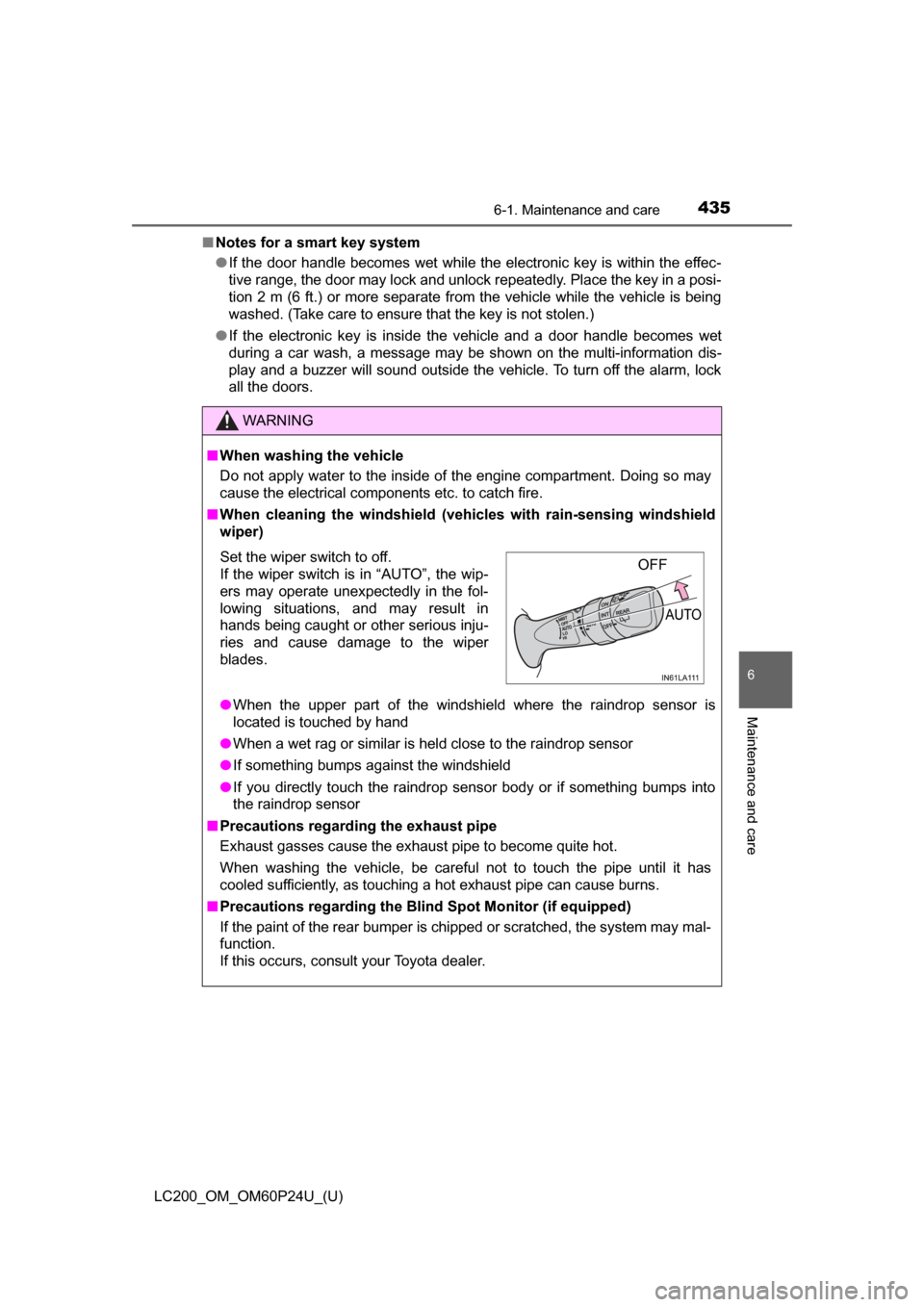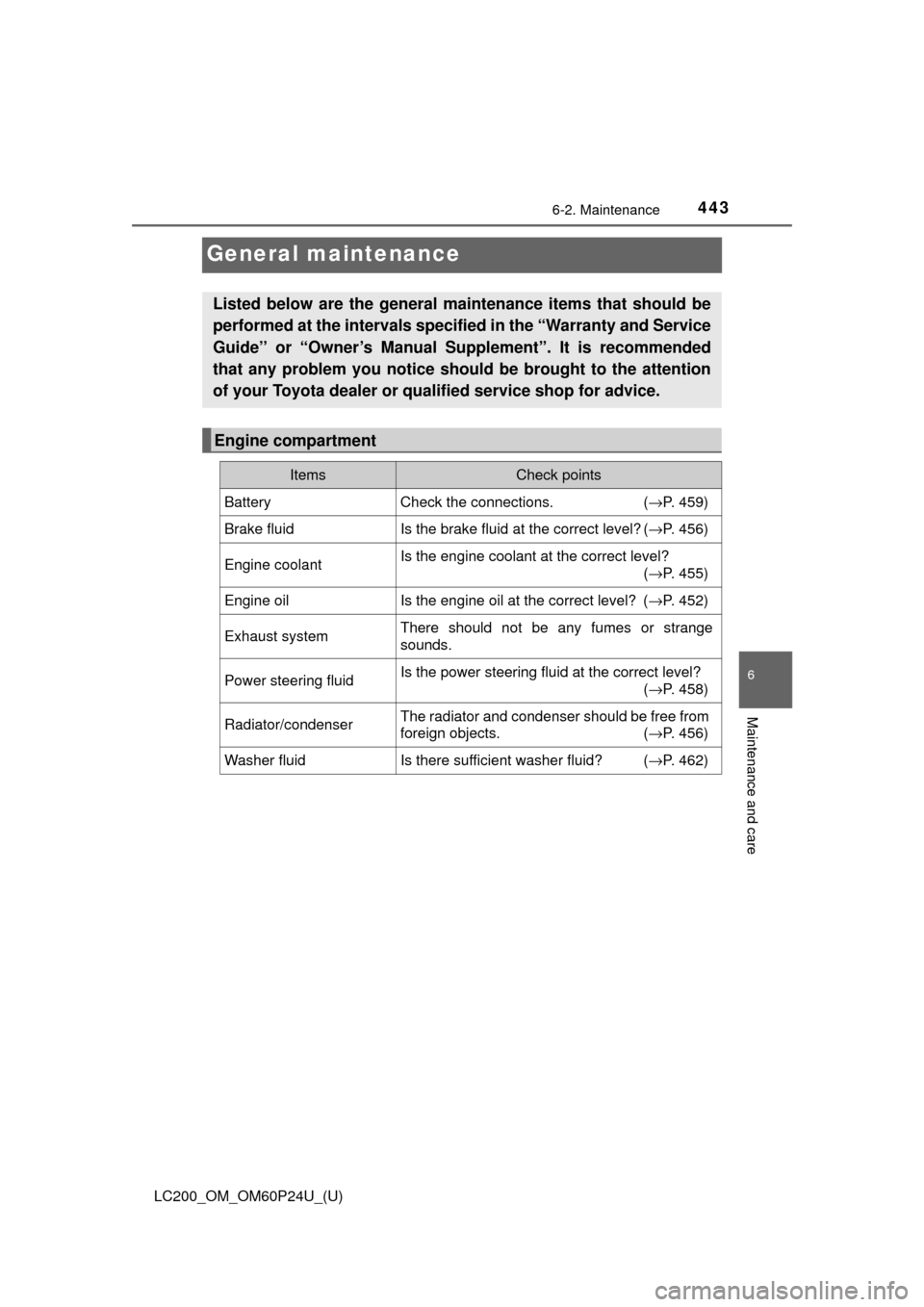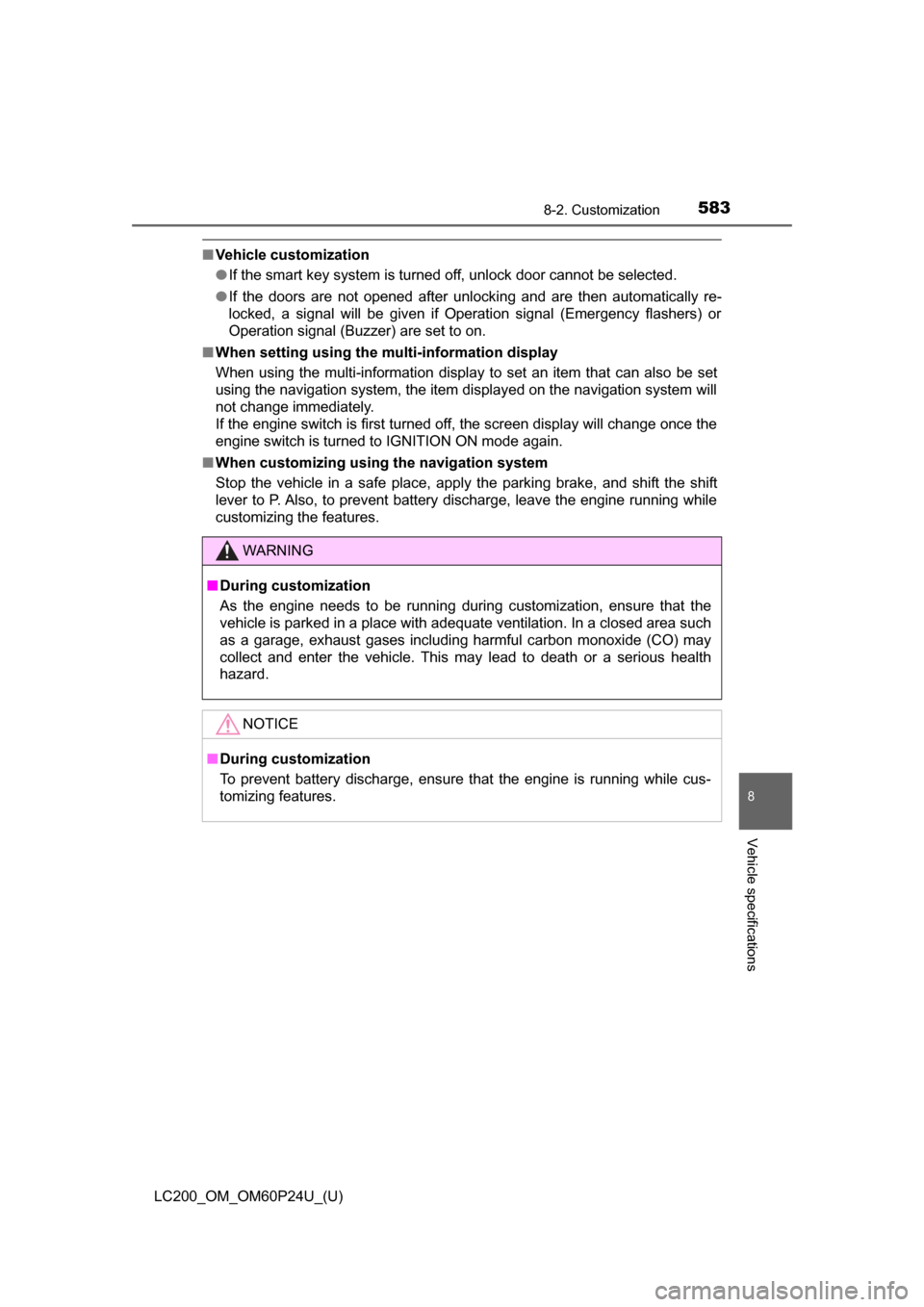2017 TOYOTA LAND CRUISER Exhaust
[x] Cancel search: ExhaustPage 435 of 608

LC200_OM_OM60P24U_(U)
4356-1. Maintenance and care
6
Maintenance and care
■Notes for a smart key system
●If the door handle becomes wet while the electronic key is within the effec-
tive range, the door may lock and unlock repeatedly. Place the key in a posi-
tion 2 m (6 ft.) or more separate from the vehicle while the vehicle is being
washed. (Take care to ensure that the key is not stolen.)
● If the electronic key is inside the vehicle and a door handle becomes wet
during a car wash, a message may be shown on the multi-information dis-
play and a buzzer will sound outside the vehicle. To turn off the alarm, lock
all the doors.
WARNING
■When washing the vehicle
Do not apply water to the inside of the engine compartment. Doing so may
cause the electrical components etc. to catch fire.
■ When cleaning the windshield (vehicles with rain-sensing windshield
wiper)
● When the upper part of the windshield where the raindrop sensor is
located is touched by hand
● When a wet rag or similar is held close to the raindrop sensor
● If something bumps against the windshield
● If you directly touch the raindrop sensor body or if something bumps into
the raindrop sensor
■ Precautions regarding the exhaust pipe
Exhaust gasses cause the exhaust pipe to become quite hot.
When washing the vehicle, be careful not to touch the pipe until it has
cooled sufficiently, as touching a hot exhaust pipe can cause burns.
■ Precautions regarding the Blind Spot Monitor (if equipped)
If the paint of the rear bumper is chipped or scratched, the system may mal-
function.
If this occurs, consult your Toyota dealer.
Set the wiper switch to off.
If the wiper switch is in “AUTO”, the wip-
ers may operate unexpectedly in the fol-
lowing situations, and may result in
hands being caught or other serious inju-
ries and cause damage to the wiper
blades.OFF
AUTO
Page 442 of 608

442
LC200_OM_OM60P24U_(U)
6-2. Maintenance
WARNING
■If your vehicle is not properly maintained
Improper maintenance could result in serious damage to the vehicle and
possible serious injury or death.
■ Handling of the battery
● Engine exhaust, some of its constituents, and a wide variety of automobile
components contain or emit chemicals known to the State of California to
cause cancer and birth defects and other reproductive harm. Work in a
well ventilated area.
● Oils, fuels and fluids contained in vehicles as well as waste produced by
component wear contain or emit chemic als known to the State of Califor-
nia to cause cancer and birth defects or other reproductive harm. Avoid
exposure and wash any affected area immediately.
● Battery posts, terminals and related accessories contain lead and lead
compounds which are known to cause brain damage. Wash your hands
after handling. ( →P. 459)
Page 443 of 608

443
LC200_OM_OM60P24U_(U)
6-2. Maintenance
6
Maintenance and care
General maintenance
Listed below are the general maintenance items that should be
performed at the intervals specified in the “Warranty and Service
Guide” or “Owner’s Manual Supplement”. It is recommended
that any problem you notice should be brought to the attention
of your Toyota dealer or qualified service shop for advice.
Engine compartment
ItemsCheck points
BatteryCheck the connections. (→P. 459)
Brake fluidIs the brake fluid at the correct level? ( →P. 456)
Engine coolantIs the engine coolant at the correct level?
(→P. 455)
Engine oilIs the engine oil at the correct level? ( →P. 452)
Exhaust systemThere should not be any fumes or strange
sounds.
Power steering fluidIs the power steering fluid at the correct level?
(→P. 458)
Radiator/condenserThe radiator and condenser should be free from
foreign objects. ( →P. 456)
Washer fluidIs there sufficient washer fluid? (→P. 462)
Page 448 of 608

448
LC200_OM_OM60P24U_(U)
6-3. Do-it-yourself maintenance
Washer fluid
(→ P. 462)• Water or washer fluid containing antifreeze (for win-
ter use)
• Funnel (used only for adding water or washer fluid)
WARNING
The engine compartment contains many mechanisms and fluids that may
move suddenly, become hot, or become electrically energized. To avoid death
or serious injury, observe the following precautions:
■When working on the engine compartment
● Keep hands, clothing and tools away from the moving fan and engine
drive belt.
● Be careful not to touch the engine, radiator, exhaust manifold, etc. right
after driving as they may be hot. Oil and other fluids may also be hot.
● Do not leave anything that may burn easily, such as paper or rags, in the
engine compartment.
● Do not smoke, cause sparks or expose an open flame to fuel or the bat-
tery. Fuel and battery fumes are flammable.
● Be extremely cautious when working on the battery. It contains poisonous
and corrosive sulfuric acid.
■ When working near the electric cooling fans or radiator grille
Be sure the engine switch is off. With the engine switch in IGNITION ON
mode, the electric cooling fans may automatically start to run if the air condi-
tioning is on and/or the coolant temperature is high. ( →P. 456)
■ When working on or under the vehicle
Do not get under the vehicle with just the jack supporting it.
Always use automotive jack stands or other solid supports.
■ Safety glasses
Wear safety glasses to prevent flying or falling material, fluid spray, etc.
from getting in your eyes.
NOTICE
■If you remove the air cleaner filter
Driving with the air cleaner filter removed may cause excessive engine wear
due to dirt in the air.
ItemsParts and tools
Page 508 of 608

508
LC200_OM_OM60P24U_(U)
7-2. Steps to take in an emergency
If you think something is wrong
●Fluid leaks under the vehicle
(Water dripping from the air co nditioning after use is normal.)
● Flat-looking tires or uneven tire wear
● Engine coolant temperature gauge needle continually points higher
than normal
● Engine oil pressure gauge continually points lower than normal.
● Voltmeter continually points higher or lower than normal.
● Changes in exhaust sound
● Excessive tire squeal when cornering
● Strange noises related to the suspension system
● Pinging or other noises related to the engine
● Engine missing, stumbling or running roughly
● Appreciable loss of power
● Vehicle pulls heavily to one side when braking
● Vehicle pulls heavily to one side when driving on a level road
● Loss of brake effectiveness, spon gy feeling, pedal almost touches
the floor
If you notice any of the follow ing symptoms, your vehicle proba-
bly needs adjustment or repair. Contact your Toyota dealer as
soon as possible.
Visible symptoms
Audible symptoms
Operational symptoms
Page 583 of 608

LC200_OM_OM60P24U_(U)
5838-2. Customization
8
Vehicle specifications
■Vehicle customization
●If the smart key system is turned off, unlock door cannot be selected.
● If the doors are not opened after unlocking and are then automatically re-
locked, a signal will be given if Operation signal (Emergency flashers) or
Operation signal (Buzzer) are set to on.
■ When setting using the multi-information display
When using the multi-information display to set an item that can also be set
using the navigation system, the item displayed on the navigation system will
not change immediately.
If the engine switch is first turned off, the screen display will change once the
engine switch is turned to IGNITION ON mode again.
■ When customizing using the navigation system
Stop the vehicle in a safe place, apply the parking brake, and shift the shift
lever to P. Also, to prevent battery discharge, leave the engine running while
customizing the features.
WARNING
■ During customization
As the engine needs to be running during customization, ensure that the
vehicle is parked in a place with adequate ventilation. In a closed area such
as a garage, exhaust gases including harmful carbon monoxide (CO) may
collect and enter the vehicle. This may lead to death or a serious health
hazard.
NOTICE
■During customization
To prevent battery discharge, ensure that the engine is running while cus-
tomizing features.
Page 597 of 608

597Alphabetical index
LC200_OM_OM60P24U_(U)
Emergency flashers ................ 500
EngineAccessory mode ................... 194
Air cleaner............................. 448
Compartment ........................ 450
Engine switch........................ 193
Exhaust gas precautions ........ 73
Hood ..................................... 449
How to start the engine ......... 193
Identification number ............ 553
If the engine will not start ...... 538
If your vehicle has to be stopped in an
emergency.......................... 501
Ignition switch (engine switch) ................... 193
Overheating .......................... 546
Engine compartment cover .... 451
Engine coolant ......................... 455 Capacity ................................ 556
Checking ............................... 455
Preparing and checking before winter....................... 370
Engine coolant temperature gauge........................................ 85
Engine immobilizer system ...... 74
Engine oil ................................. 452 Capacity ................................ 554
Checking ............................... 452
Preparing and checking before winter....................... 370
Engine switch (ignition switch)..................... 193
Engine switch light (ignition switch light) ............ 393
Event data recorder (EDR) ........ 10
Exhaust gas precautions .......... 73 First-aid kit holder ................... 405
Flat tire ..................................... 524
Floor mats .................................. 26
Fluid
Automatic transmission ........ 557
Brake .................................... 558
Steering ................................ 558
Washer ................................. 462
Fog lights ................................. 216 Replacing light bulbs ............ 497
Switch ................................... 216
Four-wheel drive system Center differential lock/unlock ......................... 282
Four-wheel drive control switch ................................. 281
Warning light......................... 514
Front automatic air conditioning system ............. 374
Front doors .............................. 106F